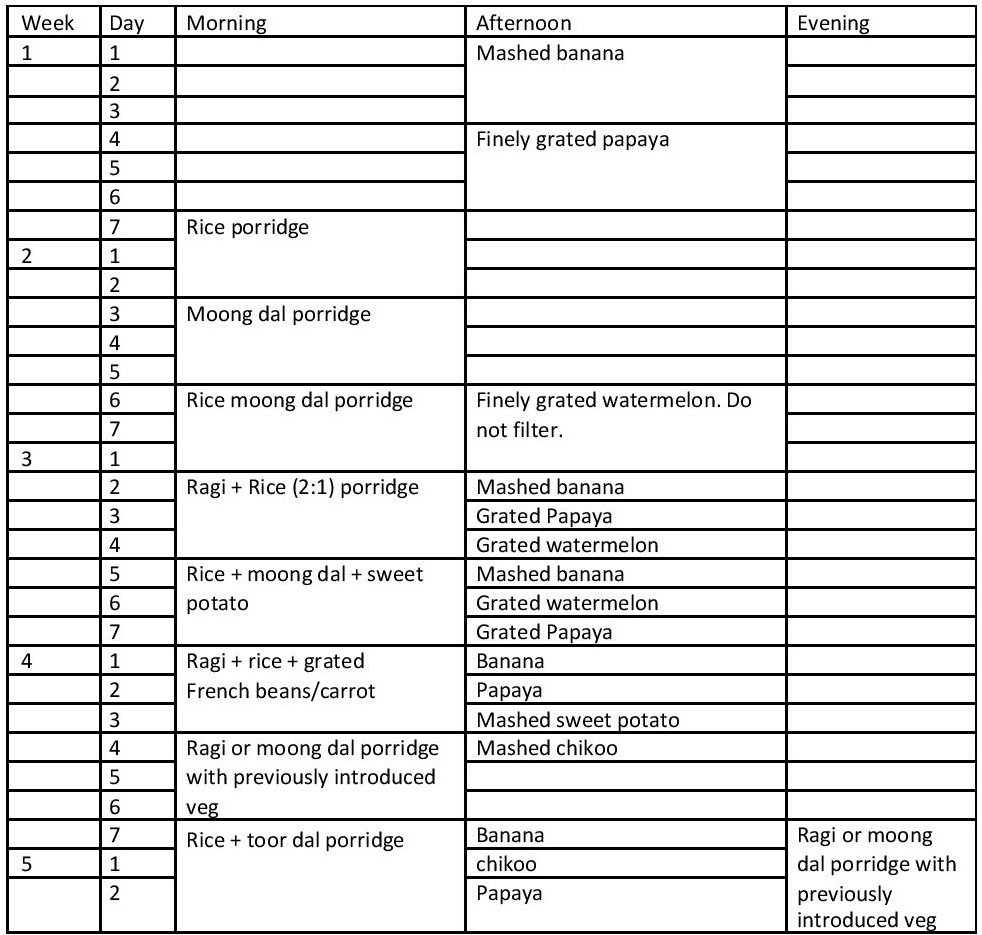Introduction to solids
When to start ?
- Babies are given breast milk or formula till 6 months of age. Once the baby completes 6 months, it is a time to introduce solids. The process is called ‘weaning’. It does not mean stopping breast milk completely.
What to start?
- Fruits:
It is preferable to start with fruits, either mashed or finely grated. Banana, chikoo, papaya, mango can be mashed. Apples, pear, guava, watermelon, musk melon can be finely grated. It is better to avoid boiling or poaching fruits as we need to introduce food the way we have it, so that the transition from baby food to adult food would be easier.
In the beginning, one fruit can be introduced at a time, once a day. - Cereals and pulses:
After baby starts digesting two – three varieties of fruits, it is time to introduce cereals. Start with rice, then add moong dal. Subsequently, ragi, wheat, bajra, jowar can be introduced. - Preparation for cereals and pulses porridge:
Wash the grain thoroughly under running water, so that there won’t be traces of boric powder. Once washed, dry the grain in the sun or under the fan. Grind the dried grain in the grinder. In the beginning, grind it to the fine powder. Gradually the powder needs to be coarser so that the goal should be feeding soft cooked rice by 9 months and feeding from your plate by 1 year of age. For cooking, take a 2 table spoons of powdered grain, add sufficient water and cook in a covered pan. Add a tea spoon of clarifiedbutter( ghee) or coconut oil to the preparation.
Do not grind cooked porridge. This preparation is common for almost all the grains and pulses, including rice, moong dal, wheat, jowar, bajra, ragi etc. For preparation of rice and pulses ( moong dal, tur dal etc) the proportion should be 3:1, 3 teaspoon rice powder and 1 teaspoon moong dal. Preparation is same as above.
- Another method to prepare porridge is to soak the grain overnight after washing thoroughly. Grind it next day morning and cook.
- The grain can be washed and tied in the muslin cloth for germinating. Later this germinated grain can be used for preparation of porridge after grinding.
Method 2 and 3 is called amylase rich food method, as soaking improves level of amylase in the grains. All three methods can be used alternately.
Vegetables:
Vegetables can be added once baby starts digesting 2-3 grains. Vegetables can either be a meal itself or as an add on to the porridge.
- Preparation:
Vegetables can be finely chopped or grated and cooked with the grains for preparation of porridge.
Vegetables can be boiled, puréed and given as a thick soup.
Vegetables like sweet potato, potato, pumpkin can be easily boiled and mashed.
Spices and condiments:
Condiments can be introduced once baby starts digesting 2-3 fruits, 2-3 grains and 2-3 vegetables. For example, elaichi (cardamom), dalchini( cinnamon) in porridge.
A small pinch of hing (asafoetida) can be added once pulses are introduced. Other spices can be experimented with from 9 months onwards.
How to introduce?
There are certain guidelines which can be followed while preparation of baby food.
- No salt and sugar for first year of life. Introducing sugar and salt earlier would lead to craving for sweet and salty food, which may lead to diabetes or high Blood pressure in the future. Instead of sugar, jaggery can be used in small amount. No honey in the first year, as there is a risk of infantile botulinism.
- Consistency should be semisolid from the beginning, so that the porridge should stay on the spoon when it is tilted a bit. The best guide to the consistency of porridge is a consistency of stools of the baby. If baby starts passing hard stools, the consistency of porridge needs to be little more watery.
- Start water at the time of introduction of solids. Make baby sip water every now and then.
- Introduce coarser food gradually so that baby should be able to eat coarsely mashed dal chawal by 9 months and eat from your plate by 1 year of age. This transition is most difficult to achieve later, if not done in time.
- After 1 month, include 2-3 vegetables at a time in the porridge.
- No junk or processed food. We do not survive on junk. We don’t eat from the box. Our daily meal is cooked at home. So should our baby have cooked meal every time.
- Once baby food is prepared use it in next 3-4 hours, else discard. Do not use leftover food to feed the baby.
- Variety is the spice of life. Do introduce different food items with variety in the food preparation.
- Rule of 3. Once a grain/vegetable/ fruit is introduced, give it for 3 days in continuum. On 4th day you can add another grain/vegetable/fruit.
- Do not overfeed. Once baby starts refusing meal, stop there. Over feeding may lead to food aversions.
Diet chart for reference:
This chart is just for the reference. No need to be stringent about this.

![]()




